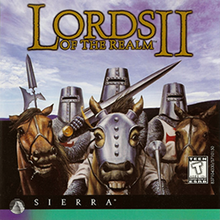Lords of the Realm II
This article needs additional citations for verification. (August 2008) |
| Lords of the Realm II | |
|---|---|
 Cover art for Lords of the Realm II | |
| Developer(s) | Impressions Games |
| Publisher(s) | Sierra On-Line |
| Director(s) | Chris Beatrice |
| Producer(s) | Eric Ouellette |
| Designer(s) | David Lester Eric Ouellette Simon Bradbury Chris Beatrice |
| Programmer(s) | Simon Bradbury |
| Composer(s) | Keith Zizza |
| Platform(s) | DOS, Macintosh, Windows |
| Release |
|
| Genre(s) | Turn-based strategy |
| Mode(s) | Single-player, multiplayer |
Lords of the Realm II is a computer game published by Sierra On-Line and developed by Impressions Games. It was first released for the PC on October 31, 1996, and is the second game in the Lords of the Realm series.
The game takes place in a medieval setting, with rulers of several counties warring for the right to be king of the land. Players grow crops, accumulate resources, manufacture weapons, manage armies, build and lay siege to castles, capture provinces, and ultimately attempt to conquer their enemies.
Gameplay
Lords of the Realm II is very different from many medieval strategy games. There is no magic, and unlike many strategy games, it has no technology tree. Players need to carefully manage food (cows, dairy, grain), population, and happiness levels whilst avoiding Malthusian population meltdowns or other players invading their counties. The game is a combination of a turn-based resource management game, in which players grow crops, accumulate resources, manufacture weapons, manage armies, build and lay siege to castles, and attempt to conquer their enemies; and a real-time strategy game, with players able to control units individually or in group formations on the battlefield.
Compared to the original, Lords of the Realm II features updated graphics and an improved management system.
Development
Impressions Games general manager David Lester commented during development, "We wanted the game to be more multiplayer friendly, and one way to do that was by adding realtime combat. Besides, when you can bring a castle down by aiming a battering ram or a catapult at it in realtime, it's a lot more satisfying."[1]
Reception
| Publication | Score |
|---|---|
| GameSpot | 7.6/10[2] |
| Next Generation |
Tim Soete of GameSpot called Lords of the Realm II "a challenging and entertaining experience for strategy enthusiasts." However, he opined that the game was overambitious in its real-time combat aspect, with troops that are difficult to maneuver and battlefields that tend to become overcrowded.[2] A Next Generation critic found it "simply an outstanding upgrade and improvement over the already excellent original." He particularly emphasized the realistic economic model, such as the fact that building an army requires drafting peasants from the population, with a resultant drop in village morale, whereas in most such games armies are built from a separate and unlimited stock of potential soldiers. Like Soete, he saw problems in the combat, such as the enemy AI's ineptitude at siege warfare, but deemed them minor issues.[3]
Global sales of Lords of the Realm II surpassed 350,000 copies by November 1997.[4] In the United States, it went on to be the 19th best-selling computer game of 1998, with 245,324 units sold. Its revenue that year was estimated at $2.99 million.[5] Its total sales reached 2.5 million copies worldwide.[6]
Sequels
The game had an expansion pack released in 1997, Lords of the Realm II: Siege Pack, consisting of new combat scenarios. It was followed years later by the much-changed sequel Lords of the Realm III.
References
- ^ "Lords of the Realm II". Next Generation. No. 18. Imagine Media. June 1996. p. 86.
- ^ a b Soete, Tim (January 7, 1997). "Lords of the Realm II Review". GameSpot. Retrieved 16 August 2018.
- ^ a b "Lords of the Realm II". Next Generation. No. 28. Imagine Media. April 1997. pp. 126, 128.
- ^ "Impressions Announces: The Lords Royal Collection" (Press release). Cambridge, Massachusetts: Sierra On-Line. November 3, 1997. Archived from the original on February 14, 1998.
{{cite press release}}: Unknown parameter|deadurl=ignored (|url-status=suggested) (help) - ^ Staff (April 1999). "The Numbers Game". PC Gamer US. 6 (4): 50.
- ^ https://web.archive.org/web/20160604010733/https://www.companiesmadesimple.com/project/blog/real-business-case-study-david-lester/
